The state of California encourages new buildings to use efficient electric heating. It encourages, but does not mandate. The mechanism for this is California’s Title 24 energy code, which requires that designs for new buildings achieve a certain number of efficiency points. The code outlines a “baseline” design that is adequately efficient. That baseline uses a heat pump for space heating, or water heating in some climate zones. The baseline design is often the cheapest way to get the number of points needed, but a builder who wants to use gas can do so by incorporating additional efficiency measures.
Typically a handful of cities adopt local building code enhancements that go beyond the state’s standard. These are called “reach codes.” Reach codes may be adopted for a variety of reasons, such as safety or aesthetics, but they are required to be energy efficient and cost-effective. In the past about 10-15 of the 550 or so local governments in California have set up energy-oriented reach codes, according to energy efficiency consultant Misti Bruceri. Think Berkeley, Palo Alto, Marin. But in recent years many more cities have established reach codes to support their climate goals. Often all-electric mandates, they do more to reduce emissions than Title 24’s points system.
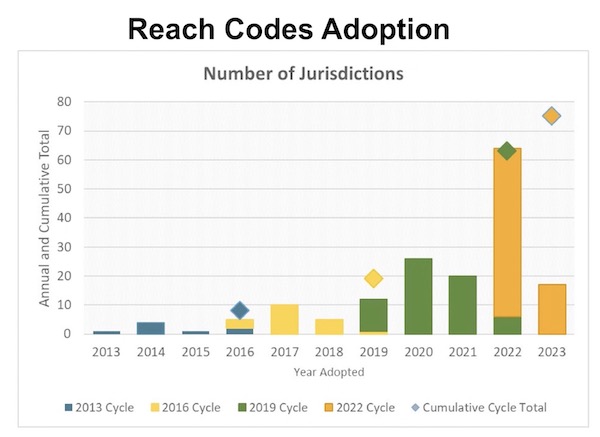
Many more local jurisdictions have adopted reach codes in recent years to support their climate goals. But an unexpected drop occurred in spring 2023. Source: Presentation by Misti Bruceri at the Redwood Energy summer retreat (2023)
You can see in the chart above that a record-high 60 cities developed reach codes that went into effect with the 2022 building code (which rolled out in 2023). But in spring 2023 the applications plummeted. What happened?
A court ruling happened. Four years ago, in 2019, the city of Berkeley passed a municipal ordinance prohibiting gas infrastructure in new buildings. The restaurant association immediately sued, saying the ban on gas conflicted with federal law (more on that ruling in a bit). The district court ruled against the restaurants, saying there was no conflict. The restaurants appealed and in April 2023 three judges on the Ninth Circuit appellate court found that the gas ban did indeed conflict with federal law. This caused many municipalities to reconsider their bids for reach codes, concerned about the prospect of legal fees and delays. It turns out that was not a bad move. Earlier this month, the appellate court declined Berkeley’s request to reconsider the ruling with a full panel of judges. The only option left for Berkeley is an appeal to the U.S. Supreme Court. In the meantime, the city’s prohibition on gas to new buildings is struck down.
So, what does this mean for local governments that want to make sure new buildings don’t rely on fossil fuels? Cities and developers want certainty when it comes to building specifications. Are these gas bans now illegal?

First, I want to briefly review the legal case. A few decades ago, in response to the oil shortage, the U.S. government developed an energy efficiency program for appliances. In many cases the government delegated the work to the states. The result was a confusing set of standards that was difficult for appliance manufacturers to deal with. So in the 1980s the federal government took control of the standards and specifically prohibited states from setting their own, stating that once a product has a federal standard, “no State regulation concerning the energy efficiency, energy use, or water use of such covered product shall be effective with respect to such product.”
The majority of judges in the appellate court understood this to mean that any state regulation that affects “energy use” is prohibited. Since a ban on gas infrastructure precludes any energy from being used (by gas appliances), it must be illegal. But there was concern that this ruling was very broad and took away too much local control. After all, many ordinances can indirectly impact energy use. Berkeley asked for a larger set of judges to rehear the case. But two weeks ago their request was denied.
The judges did make an effort to clarify and narrow the ruling but the opinion remains divisive. An uncommon dissent signed by 11 of the 50+ judges writes that interpreting “energy use” here to mean the amount of energy used by a consumer is incorrect. They write that “energy use” in this context specifically refers to a property of an appliance, similar to energy efficiency, something that can go on a label. The presence or absence of gas infrastructure does not affect it. You can read the full appellate court’s ruling here, with the dissent starting on page 50.
Will Berkeley appeal to the Supreme Court? We don’t know. Will a federal court in another circuit find differently than the Ninth District, forcing the issue? We don’t know. In the meantime, the problem is that the appellate court ruling is not definitive. Bruceri says “It raises more questions than it answers.” The ruling states that “Our holding here is limited. We conclude only that EPCA (the federal law) applies to building codes and that Berkeley’s Ordinance falls within the Act’s preemptive scope.” Senior Attorney Matt Vespa, with environmental law firm Earthjustice, says it’s not clear which types of gas prohibitions this might affect. “The decision got modified (by the appeals court) to talk about the building code. It’s more narrow, supposedly, but it doesn’t say why it’s narrow.” So what is a city or a developer to do?
Bruceri notes that there are a range of approaches that cities can take depending on their tolerance for risk. “We love Berkeley, but not every place is a Berkeley.”
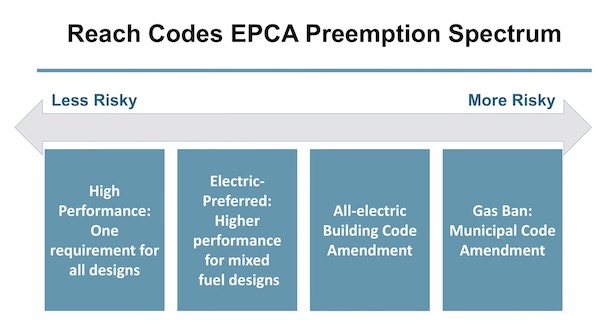
Local jurisdictions have a range of options for reach codes, from the least risky approach of enhancing the state’s minimum standards, on the left, to changing city law on the right. Many mid-Peninsula cities currently have reach codes that match the third box -- all-electric building codes. Source: Presentation by Misti Bruceri at the Redwood Energy summer retreat (2023)
The least risky option is to use the same structure as the state’s energy code, which is allowed by federal law, and push on it a little. San Jose, Santa Cruz, and San Luis Obispo have gone this route and the town of Atherton is looking into it. These reach codes tighten the state’s requirements for “energy source”, which is a proxy for emissions, while leaving the other efficiency standards in place. An efficient home with heat pumps for both space and water heating can satisfy these reach codes but other pathways are possible. For example, a home with a gas furnace might need to install triple-pane windows, some extra PV panels, and a battery.
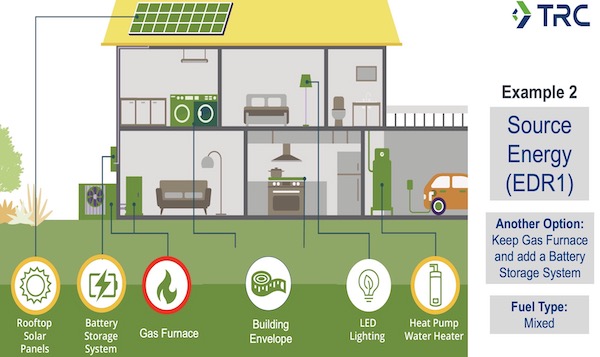
In the reach code approach that Atherton is considering, a developer could put a gas furnace in a new home, but would need to add additional efficiency measures, such as the battery storage system shown here. Source: Presentation by TRC Companies for Atherton’s City Council (2023)
The town of Los Altos Hills is pursuing a different approach, a “performance standard” that is based on emissions rather than energy. The Bay Area Air Quality Management District has done this, as has New York State. Because these standards regulate emissions rather than energy, they are less likely to conflict with the federal law at issue in the Berkeley ruling. Moreover, they can have scope beyond just space and water heating. Los Altos Hills’ code will cover clothes drying but not cooking, and will require electric readiness in kitchens. They plan to cover significant remodels in addition to new construction, though lower-income households and involuntary remodels would be exempted.
What these municipalities all have in common is a desire to discourage local homeowners from installing appliances that will soon be out-of-date, that will be harder to find support for, and that will be subject to increasing rates as other homes use less gas.
Although California cities are continuing to make good efforts to reduce their emissions, they would like to move beyond the patchwork of reach codes, especially in light of the recent litigation. Representatives from 23 California cities, including San Francisco, Los Angeles, Sacramento, and San Jose, have asked Governor Newsom to support a state-wide zero-emission building code. “Without your administration stepping in, local governments and Californians more generally will be stuck with polluting buildings and infrastructure we do not want or need – and many municipalities will be forced to backtrack on progress cutting emissions from buildings, due to insufficient resources to fight frivolous and opportunistic lawsuits.” Vespa says that a zero-emission initiative would likely be done through CALGreen, the state’s green building code, rather than through Title 24 since CALGreen can target emissions rather than energy efficiency. The California Air Resources Board has drafted a proposal for CALGreen.
So despite the Berkeley litigation, there continue to be many initiatives pushing for fossil-free buildings at the city, regional, and state level. Vespa is hopeful that even the state’s energy code will catch up soon. “Things have changed since Berkeley first passed its ban in 2019. The state’s energy code is getting a lot closer, motivated in part by local government action. The California Energy Commission is working on updates to Title 24 for the next building code, which will take effect in 2026. They are proposing a baseline that would have heat pumps for both space heating and water heating in residential buildings. The building code that Washington State just passed has a similar baseline. And the interesting thing is, we haven’t seen the builder pushback that we saw in the last building code cycle.”
The developer momentum is apparent in adoption curves for heat pumps. The market is responding to the regulations. By the end of 2022, even before the current building code went into effect, over 50% of new buildings in California used heat pumps for space heating. (1)
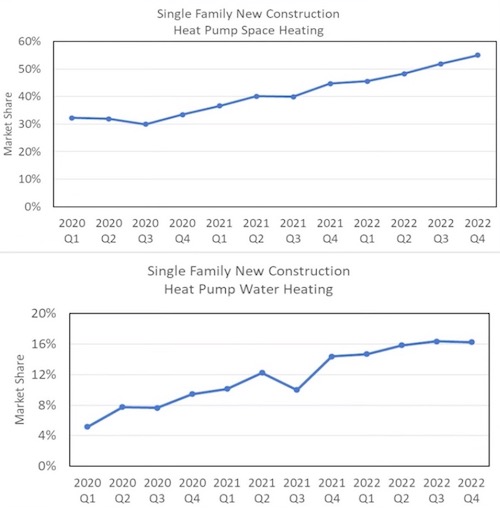
Heat pumps for both space and water heating are increasingly being designed into new buildings, even prior to 2023 when the building code that encourages them went into effect. Source: CEC Staff Workshop 2025 Energy Code on Heat Pump Baselines (2023)
“The culture has changed”, says Vespa, though there is still a lot of work to be done to continue to get contractors on board and to fill equipment gaps. (2)
I mentioned to Vespa that builders in Washington State protested that an aggressively electric building code for new construction would hurt affordable housing. “Well, we have heard from affordable developers. There has been money in technical assistance. There’s an initial cost to redesign your standard home and what that looks like. But once you’ve figured all that out, it’s actually just less…. I think if we really saw that playing out in a material way, we’d be hearing about it, and we’re not. If you think it through, why is this more expensive? You are avoiding all these other gas-related expenses once you go all-electric.” For homeowners, he also touted the advantage of the air-conditioning (which comes for free with heat pumps) in the increasingly hot Central Valley, the ability of these appliances to filter smoke, and the free energy that comes from built-in solar panels in new homes. There is no free gas! And of course these appliances produce less pollution and fewer emissions. “This is a win on so many fronts.”
The Berkeley ruling is a bump in the road but not a roadblock. Local municipalities can continue to develop reach codes to help meet their climate goals and future-proof buildings in their city. Regional regulations that govern appliances’ air pollution can focus on health and safety standards. And the all-important statewide building codes continue to move away from gas. Equipment manufacturers are committing and many initiatives are underway to train contractors, all of which drives costs down. An effort that started years ago in Berkeley and in small mid-Peninsula towns is only gaining steam.
Notes and References
1. Our heat pump installation rates still pale in comparison with those in the southeastern states, where heat pumps are by far the dominant source of heating and cooling because of their efficiency and their dehumidifying capabilities.
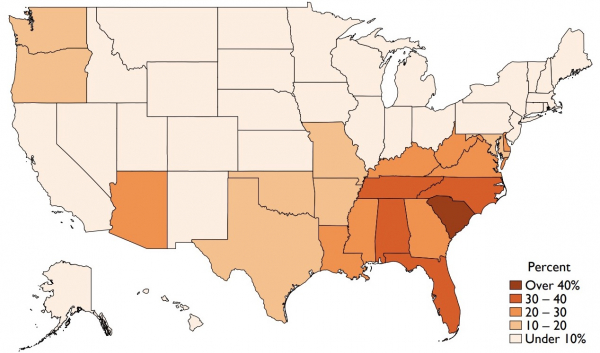
Heat pump adoption rates per state. Data from 2020. Source: The Economic Determinants of Heat Pump Adoption by Lucas Davis (July 2023)
2. Redwood Energy’s Sean Armstrong keeps track of some of these gaps. In this brief talk, for example, he specs out the need for cold-weather portable and window heat pumps, similar to air conditioner units that many renters use. They would cost $700, be very quiet, have self-cleaning coils, and work well at low temperatures, combining features from some of today’s heat pumps.

Source: Presentation by Sean Armstrong at the Redwood Energy summer retreat (2023)
Current Climate Data
Global impacts (December 2023), US impacts (December 2023), CO2 metric, Climate dashboard
Comment Guidelines
I hope that your contributions will be an important part of this blog. To keep the discussion productive, please adhere to these guidelines or your comment may be edited or removed.
- Avoid disrespectful, disparaging, snide, angry, or ad hominem comments.
- Stay fact-based and refer to reputable sources.
- Stay on topic.
- In general, maintain this as a welcoming space for all readers.



